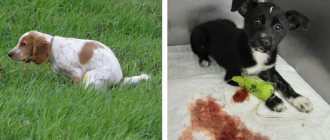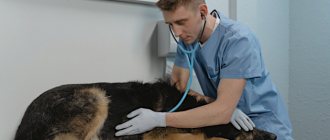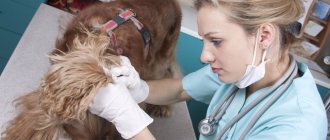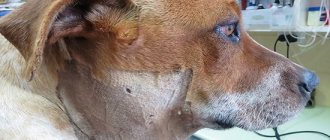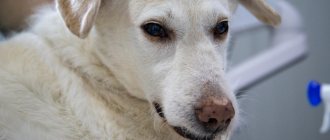Blood and mucus in a dog’s stool can appear for a variety of reasons: mechanical trauma, household poisoning, and even an infectious disease. That is why, if traces of blood are detected in your pet’s stool, it is necessary to promptly seek help. Leading specialists from the Berloga veterinary clinic in Moscow talk about what to do and how to treat a dog to avoid dangerous consequences.
Read in this article
Causes of blood and mucus in the stool If you find blood and mucus in the stool What should you do if there is blood in your dog's stool?
Diagnostic methods
Dog treatment
Therapeutic diet
Prevention
Causes of blood and mucus in stool
The appearance of blood and mucus in a dog's stool is an alarming sign. It can indicate serious illnesses, so it should never be ignored. Most often, blood in your pet's stool occurs due to poor diet. For example, if your dog often overeats, eats irregularly, or has a diet that is high in fat.
Other common causes of bloody stool in dogs include:
- Infection with helminths. Penetrating into the animal’s body, parasites cause damage to the intestinal mucous membranes, so there may be traces of blood and mucus in the stool;
- Infectious diseases. The most common among dogs: parvovirus enteritis, leptospirosis, etc. At the same time, puppies under 1 year are at particular risk.
- Oncology . In some cases, the appearance of blood in your pet's stool may indicate the presence of a malignant tumor in the gastrointestinal tract;
- Inflammation . Blood in the stool is one of the signs of inflammatory processes occurring in the small or large intestine;
- Hemorrhagic gastroenteritis (HGE). In this condition, the stool is brightly colored with red blood; an additional symptom of the disease is profuse diarrhea;
- Swallowed objects . Small foreign bodies (buttons, small toys) lead to microtraumas, resulting in bleeding;
- Paraanal sinusitis . This condition is accompanied by inflammation of the anal glands, which leads to the appearance of blood in the stool;
- Other reasons . Other factors that can cause bloody stools include: stomach or duodenal ulcers, chemical poisoning (for example, household chemicals), as well as frequent constipation, stress and hypersensitivity.
In some cases, the owners themselves are involved in the problem of blood appearing in the animal’s stool. It is not recommended to give long bones to dogs. Once in the digestive system, sharp fragments can damage the mucous membranes, resulting in the presence of blood impurities in the stool.
If you find blood and mucus in your stool
Often, finding blood in the stool is not the only sign that your pet has a health problem. Additionally, mucus may be present in the stool. Another sign of a serious problem is vomiting. Together, these symptoms are often observed in the following conditions:
- hemorrhagic colitis,
- neoplasms,
- proctitis,
- adenovirus infection,
- severe poisoning.
Why vomiting
In episodes of diarrhea, it is often accompanied by vomiting. Together, these symptoms occur in many diseases, the nature of which can be described as either infectious or non-infectious. Sometimes this is simple poisoning, but if these symptoms appear in puppies, this is a clear sign of a viral infection.
Let's consider several common diseases that are accompanied by joint vomiting and diarrhea:
- Parvovirus enteritis does not occur in dogs older than one and a half years. Characterized by low temperature, refusal of food and water. The disease progresses quickly and has a high mortality rate.
- Infectious hepatitis develops over 2 weeks and occurs in animals of any age. On examination, he is characterized by an enlarged liver.
- Coronavirus enteritis, you are dealing with it if the dog’s temperature remains above normal for a long time (39 ° C).
There are also dogs that have diarrhea and vomiting regularly, without other symptoms of illness. Doctors confirm that some dogs have this feature of their physiology, inherited from ancestors who were predators.
What to do if there is blood in your dog's stool?
First and most importantly, do not self-medicate. A variety of reasons can cause bleeding, so it is impossible to identify them at home. Not only will you not help your pet, but you will also aggravate an already difficult situation.
Therefore, if you find blood in your stool, seek professional help immediately. Before coming to the veterinarian, prepare answers to several questions:
- What did you feed your dog for the last 2-3 days?
- Could your pet pick up an inedible object on the street or at home?
- Have similar situations happened before?
- Do you give your pet any medications?
If possible, take a photo of bloody stool. Do not throw away the stool; prepare it for laboratory testing. This will significantly save your time and allow the veterinarian to take all necessary measures in a timely manner.
If contacting a specialist is delayed for certain reasons, exclude dry food and solid food from the dog’s diet. This way you will be sure that it does not injure the mucous membranes of the gastrointestinal tract.
Under no circumstances should you apply cold/heat to your dog’s belly. Do not prescribe medications yourself. And most importantly, don’t panic. Drops of blood in the stool can be disposable and self-limiting, but, of course, this does not exclude the need for a full and professional examination.
Diagnostic methods
If your pet is completely healthy, then the color of his feces should be brown or dark brown. If you find blood in your dog’s stool, do not delay visiting a specialist - only a professional veterinarian can quickly and accurately determine the cause of this condition, as well as prescribe effective treatment.
Diagnostic stages:
- Visual inspection . Tell your veterinarian when, how often, and how much blood was present in your pet's stool.
- Laboratory research . The specialist will prescribe a stool test (including for the presence of helminthic infestations), as well as a biochemical blood test.
- Ultrasonography . An ultrasound of the abdominal organs is performed to ensure there are no injuries.
- Gastroduodenoscopy . If necessary, a specialist visually examines the upper intestines.
- Other research methods . In a veterinary clinic in Moscow, enteroscopy, x-ray, and rectocolonoscopy are prescribed for diagnosis.
Once the veterinarian has identified the cause, he will prescribe a treatment program. It is developed taking into account the general condition of the pet, the diseases detected and the amount of blood that was lost. By strictly following the specialist’s instructions, you can quickly restore the animal’s condition and avoid the dangerous consequences of blood loss.
If your pet has previously had similar problems, bring all available laboratory results, prescriptions and treatment plan to the veterinary clinic. This will help the specialist in drawing up a treatment program.
Feeding rules
When you notice liquid discharge from your dog, stop feeding it. It is advisable to leave the dog without a feeder for at least a day. Give only water, and plenty of it, to combat dehydration.
After a hungry day, give your pet a decoction of rice or rice itself, only well-cooked. To normalize the intestinal microflora, fermented milk products are good. As a remedy for diarrhea, some recommend black tea, only weak, with added sugar. You need to save such a menu for at least a couple of days and make sure that the disease recedes.
Once the diarrhea has stopped, you should plan your pet's menu for a few weeks to avoid heavy or fatty foods. The best choices are broths, rice porridge and fermented milk products.
Prolonged diarrhea will indicate a serious illness. Here you need to immediately run to the doctor. As in cases where your pet refuses to eat and drink with diarrhea, has a high fever, vomiting, coughing with snot and tears.
Dog treatment
The first stage of treatment is to stop bleeding and restore the volume of blood in the pet’s body necessary for the normal functioning of internal organs. For these purposes, the veterinarian prescribes a blood transfusion procedure and prescribes medications that stop internal bleeding.
The second stage of treatment is symptomatic therapy. It involves prescribing various medications:
- hemostatic,
- to restore water and electrolyte balance,
- from anemia,
- wound healing,
- anti-inflammatory, etc.
If blood and mucus in a dog's stool is due to the formation of a malignant tumor in the large intestine, surgery is indicated. Surgery is also recommended if a foreign body is detected in the digestive system, which if not eliminated can lead to other dangerous consequences.
If infectious diseases are detected, the veterinarian will prescribe antiviral and antibacterial drugs for your pet. Additionally, immunomodulatory therapy is prescribed, which involves taking vitamins to strengthen and restore the functioning of internal organs, as well as the general condition of the dog.
Is it possible to give medications?
The veterinarian you contact for help should prescribe medications. To choose therapy, the doctor needs to familiarize himself with the test results, and the selection of medications becomes a matter of individual cases. At home, it is better to limit yourself to a diet and, perhaps, a couple of tablets of activated carbon dissolved in water.
At the clinic, they will almost always provide you with anti-worm tablets first. Then your pet will have an IV installed. The solution entering the animal’s blood will have several effects at once: against infection, against inflammation. The tablets will resist inflammation in a less aggressive form. Critical cases will require antibiotics.
Therapeutic diet
If the cause of blood in your pet’s stool is improper feeding, frequent constipation or diseases of the gastrointestinal tract, then a specialist will prescribe a diet. Strictly adhere to the rules indicated by him, since dietary food is selected to suit the specific needs and characteristics of the dog.
Basic principles of a therapeutic diet:
- It is necessary to feed your pet in small portions, but at short intervals . Thus, the amount of food remains the same, but it is consumed at different periods of time. It is desirable that the intervals between feedings be the same (for example, 2 hours);
- Avoid low-quality dry food . In the first 5-10 days, give your pet low-fat meat broth, cottage cheese, rice with chicken and other foods with minimal fat content. This will reduce the load on the digestive system;
- Make sure your dog always has clean drinking water.
FAQ
How to treat diarrhea in puppies?
Diarrhea in puppies is treated in exactly the same way as in adult dogs, the only significant difference will be the duration of the fasting diet - a maximum of 10 - 12 hours.
Is it possible to give a dog “human” drugs: chloramphenicol, imodium, activated carbon, loperamide, smecta, furazolidone, enterofuril, polysorb, lopedium for diarrhea?
It is possible, but you should consult your doctor before use. Since each organism is individual and requires its own approach.
Prevention
In some cases, blood in your pet's stool can be prevented. To do this, just follow the simple recommendations given by the specialists of the Berloga veterinary clinic in Moscow. Basic preventive measures:
- Anthelmintic treatment . Typically, anti-parasite medications are given once every 3 months. However, if you notice worms in your pet, then treatment must be carried out 2 times, and the interval between them should not be more than 10-14 days;
- Keep an eye on your pet's stool . This will allow you to timely detect the problem and seek professional veterinary help to avoid complications and other dangerous consequences;
- Ensure proper feeding . A dog's diet should contain protein, fiber and fats. It is important that the amount of food and frequency of feedings correspond to the weight of your pet. Make sure he doesn't overeat and don't give your dog sharp bones;
- Special diet . This is an effective method of prevention, but only if the animal has a predisposition to diseases of the digestive tract. Therapeutic diets maintain healthy microflora and help avoid bleeding;
- Walks . Take extra care when walking your dog. It is important that the pet does not pick up anything from the ground: it can easily swallow small foreign objects that damage the mucous membranes of the stomach;
- Routine vaccination . Once a year, go to the veterinary clinic for a routine examination and antiviral vaccination. In the future, this will avoid dangerous viral consequences, the symptoms of which may be blood and mucus in your pet’s stool.
Remember that animals need professional veterinary care if they have blood in their stool. We strongly do not recommend self-medication, because the health of your dog depends on how promptly you contact the veterinary clinic!
